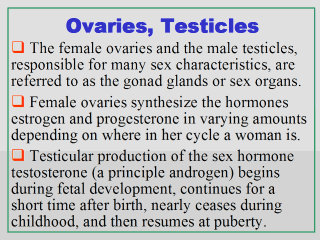| front |1 |2 |3 |4 |5 |6 |7 |8 |9 |10 |11 |12 |13 |14 |15 |16 |17 |18 |19 |20 |review |
 |
The gonads
are the female’s ovaries and the male’s testicles, or otherwise more
commonly referred to as the sex (or sometimes also the reproductive) organs.
In addition to producing gametes (ova and sperms), these sex organs secrete
hormones. As mentioned earlier (Slide
8), the secretion of these sex
hormones by the gonads is controlled by pituitary gland hormones such as the
FSH (follicle-stimulating hormones) and LH (leutinizing hormones). While
both sexes make some of each of these hormones, male testicles secrete
primarily androgens of which testosterone is the principle one. Female
ovaries make estrogens and progesterone in varying amounts depending on
where in her cycle a woman is. In a pregnant woman, the baby’s placenta also
secretes these hormones to help maintain the pregnancy. The estrogens and progesterone contribute substantially to the development and the function of female reproductive organs and sex characteristics. At the onset of puberty, estrogens promote several physiologic processes: distribution of fat evidenced in the hips, legs, and breast; development of the breasts; and maturation of reproductive organs such as the uterus and vagina. Progesterone causes the uterine lining to thicken in preparation for pregnancy. Production of testosterone in males begins during fetal development, continues for a short time after birth, nearly ceases during childhood, and then resumes at puberty. This steroid hormone is responsible for several growth and sexually-related functions. These functions include but are not limited to: growth and development of the male reproductive structures; increased skeletal and muscular growth; enlargement of the larynx accompanied by voice changes; growth and distribution of body hair; and increased male sexual drive. |